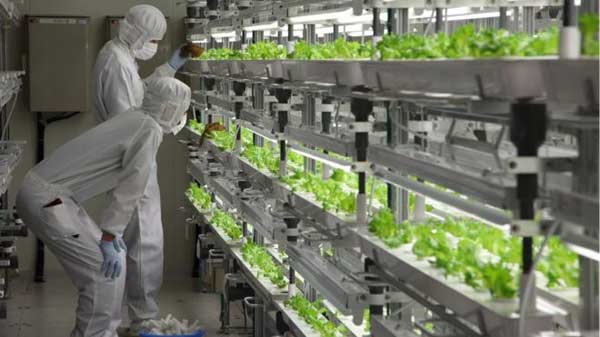
Tokyo, Japan (BBN)-Since off-season cucumbers were grown under "transparent stone" - an early version of the greenhouse - for the Roman Emperor Tiberius, we've been trying to bend Mother Nature to our will.
We've even learned how to grow plants without soil, feeding them directly with mineral nutrients in water, often under artificial light, reports BBC.
Hydroponics - as this is called - has always remained a niche method of food production, but now the latest technologies are giving it a new lease of life.
They're even trying it in space.
Could this way of growing plants help feed our rapidly growing - and increasingly urbanising - global population?
FROM SEMICONDUCTORS TO SPINACH
At its Aizu Wakamatsu factory in central Japan, tech firm Fujitsu is applying cloud-based data analytics to the production of low-potassium lettuce and spinach.
The operation takes place in a dust-free "clean-room" formerly used for semiconductor production.
WHAT'S SO GREAT ABOUT HYDROPONICS?
No need for soil means more food can be grown on less land
This is ideal for a growing, urbanising global population
Yields can be up to 10 times more than from open field agriculture
The water used can be recycled
Farms can be anywhere, from skyscrapers to shipping containers
Pollution from pesticides and herbicides can be contained
Local production reduces food miles and transportation costs
Fujitsu's cloud platform - Akisai - stores and analyses data from lots of sensors in the greenhouses, and enables heating units, ventilation fans and other equipment to be operated remotely.
"In terms of quality, we have applied the same industrial perspective from semiconductor manufacturing to vegetable cultivation," a Fujitsu spokesman tells the BBC.
"Having a control structure that keeps product specifications - the weight and nutrient constituent-parts of lettuce - within a defined range, makes for effective high added-value vegetable production."
The company sells the lettuce it produces to hospitals, supermarkets, and hotels - as well as online - and says its cloud service is collecting valuable data that is leading to improved quality and higher yields.
Fujitsu's insights and efficiency improvements could also encourage more producers to enter the market and "lead to an increase in younger generations getting into agriculture", the spokesman adds.
AUTOMATIC FOR THE PEOPLE
In China, start-up company Alesca is turning disused shipping containers into highly automated hydroponic mini-farms.
The units require no more than two hours of labour per week, says founder Young Ha, a former Dell employee, because software takes care of most of the maintenance.
"We chose to start with a shipping container because it's possible to achieve optimal conditions for each type of plant grown," he says.
Ha claims the mini-farms produce more crops per square metre than any other farming method.
"We are using the latest efficient LED lighting, and building automation and software tools to achieve this," he says.
"Our automation and control system listens and monitors plants through sensors and tells us how they are growing, how healthy they are, and if we need to adjust the environment and nutrients automatically to reach more optimal growing conditions."
Ha believes Alesca's containers could offer hyper-local food production in densely populated urban areas.
"We call this zero-mile food, where anybody can grow their own food or can find a farm nearby to buy the freshest food from," he says.
FLOURISHING BUSINESS?
Research firm Ibis World puts the hydroponic industry's annual revenues at a modest $555m (£372m; €512m) - growing at about 3.3 per cent per year.
This is because it has always been difficult to scale up production, dependent as it is on power for the lighting, cooling and feeding systems.
It also needed quite of lot of human intervention.
But Ibis analyst Nick Petrillo believes such automation tech and cloud-based data analytics could give the industry a growth spurt.
"Nutrient replacement, pH monitoring, temperature, lighting, humidity and other controls that might be done manually could all benefit from software and hardware that automates the entire process," he says.
This would save a lot on labour costs and make hydroponic food more commercially attractive to retailers, whilst also helping to feed a global population projected to reach 9.6 billion by 2050.
LIVING MACHINE
Some people are hatching even bigger hydroponic plans.
US-based Urban Skyfarm has designed a 525ft (160m) energy-efficient vertical hydroponic farm, which would use sunlight as the main lighting resource and LED lighting as a back-up.
Equipped with photovoltaic panels and wind turbines on the roof to generate renewable energy - and water filtration systems on the underground level - the entire system would act as a living machine, says co-founder Steve Lee.
"Through lifting the main food production field high up in the air, the vegetation gains more exposure to natural sunlight and fresh air, while the ground level becomes more freed up with nicely shaded open spaces, which could be enjoyed by the public," says Lee.
The scheme is just a concept at this stage, but he plans to pitch the idea to municipal governments next year.
But Carol Stimmel, founder of tech advisory firm ManifestMind, warns: "Not all roads end in a fully automated, hermetically sealed vertical greenhouse, even in advanced economies."
Growers in many countries face unreliable electricity supplies, insufficient infrastructure, and unskilled workers, she says.
Nevertheless, she agrees that novel technologies could finally help hydroponic food production achieve industrial scale and help feed the world.
BBN/SK/AD